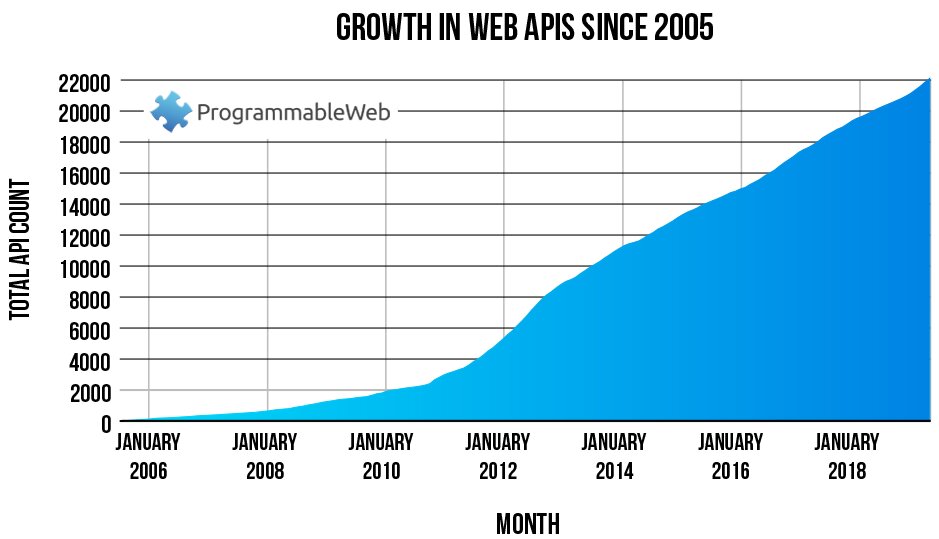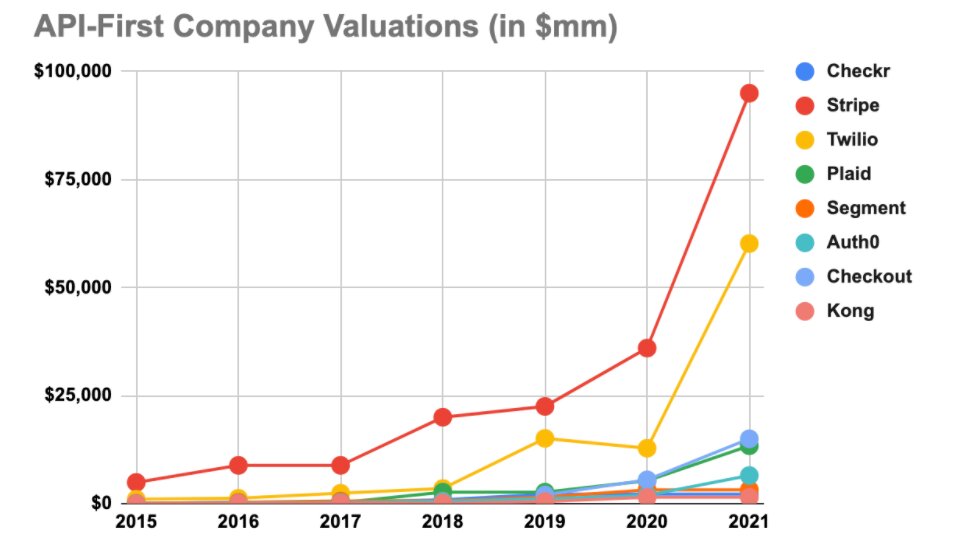Got your time machine? Good. Rewind to 2002. That’s when Jeff Bezos published Amazon’s famous internal API mandate,, requiring all teams to “expose their data and functionality through service interfaces.” They were also required to “communicate with each other through these interfaces,” regardless of what technology they were using. This agile infrastructure enabled Amazon to launch relentless new businesses, including AWS, Amazon Alexa, and the whole suite of Amazon Prime products and services.
At the time, APIs were almost a nonexistent idea. Jeff Bezos seemed crazy for implementing this mandate. But in hindsight, this looks like the obvious move—today, APIs are everywhere! Recently, the number of public APIs hit 24,000. McKinsey estimates that this number will triple over the next 12 months.

In addition to external/public APIs, there’s even a bigger chunk of growing internal / private APIs. Usage across all industries is increasing. Take a look at the RapidAPI chart below, showing increasing demand compared to prior year in every major industry:

While this growth is impressive, there’s still a lot of room to grow. Most enterprises don’t take advantage of the vast trove of assets and capabilities within their organization, leaving the rest in siloes and hardwired. They still rely on people (instead of APIs—hence the rise of RPA companies) to free up those assets to other teams to build new products on top of them. Migration to the cloud and shifting to dynamic networks of microservices architecture (no more monoliths) will accelerate the transition from legacy applications to self-service composable services, just like what Bezos required in 2002.
Younger companies, like the ones we see at AV8 Ventures, have an advantage here because they can strategically adopt APIs from the beginning, with an API-first mentality. This means creating modular products with microservices architecture. To do this, companies first identify core competencies of their business. They then build in-house only those that differentiate them in the eyes of their customers. They use 3rd-party APIs for all the non-core areas. Gone are the days of building the full stack in-house. They can’t afford to build a payment stack, but they don’t have to: Stripe already hired an army of developers to perfect that function. Likewise, they can’t afford to build a map solution, but they don’t have to: Google already spent billions of dollars building the Google Maps API that everyone (including Tesla) is using.
Ease of use of such powerful services through a single API has led to a Cambrian explosion of startups that take advantage of 3rd-party APIs for non-core features to speed up product development cycles. Stripe has more than 2 million customers, the majority of which are smaller companies using its API to process payments.
Now, value creation has hit an inflection point, creating many API-first unicorns/decacorns in the last decade:

This is just the beginning. As APIs become the connective tissue of any enterprise, there will be many more opportunities. Here are a few things I’m watching out for.
-
API Development & Management: While 3rd party APIs are empowering developers, there’s a similar-sized opportunity with the internal APIs within an enterprise. This is what Jeff Bezos’ API mandate was about. Most enterprises still don’t have an API-first mentality when it comes to interactions among internal components and teams. Companies like Mulesoft – now Salesforce (management), Kong (management) and Postman (development / testing) are making great progress on those challenges. Other startups such as Speedscale (testing) and Tyk (open-source gateway) are interesting. Orchestrating the growing network of APIs may end up requiring stand-alone solutions. Today, backend API management tools seem to address that. A quick way to get to a solid documentation for APIs would have a huge impact in API adoption within an enterprise. Anyone know innovative approaches here?
-
API Monitoring & Visibility: Teams want to have visibility and then monitor their API footprints. This was easier when they had few APIs to manage. Complexity significantly increased with the dynamic world of more internal and 3rd party APIs. In order to avoid costly downtimes (avg downtime costs $5600 per minute) and ensure availability/performance, continuous visibility into API metrics is critical. Apart from traditional APM vendors (Datadog, Splunk, etc.), exciting startups to watch include APImetrics, Checkly and Moesif.
-
API Security & Compliance:With the expanding API footprint, there will be growing demand for API security as more surface area will be exposed through APIs. Gartner forecasts that API abuses will become the most frequent attack vector in a few years. Companies such as Salt, Noname and Traceble provide solutions to cover growing API exposure. CloudVector (recently acquired by Imperva) addresses the crucial step of discovery/API cataloging i.e. what APIs do I have?
-
API-first business functions: There is a long list of successful API-first companies today. There are still many business functions—horizontal (security) or vertical (insuretech, fintech, proptech, etc.)—that could be delivered through an API. I’m interested in innovative API-first models addressing large markets. Innovative APIs I like include: Planck Data (for P&C insurance), Veriff (identity verification), Hubuc (banking-as-a-service), Duffel (Flight sales), and Contentful (Headless CMS).
-
International:We have seen many impressive success stories in the US. Plaid. Stripe. Twilio, and many others. While these players have some international footprint, there’s room for local innovation (e.g. KYC in India, AML in Europe, Payments in Africa, etc).
APIs are one of the most exciting trends in software development we are presently tracking at AV8 Ventures. There are still massive amounts (billions of dollars) of annual IT spend that could be productized through APIs. We’re excited to support founders who are building innovative solutions in this evolving ecosystem, so if you’re working on an exciting API company, please get in touch. Also, please comment below if you have thoughts about this space.


0 Comments